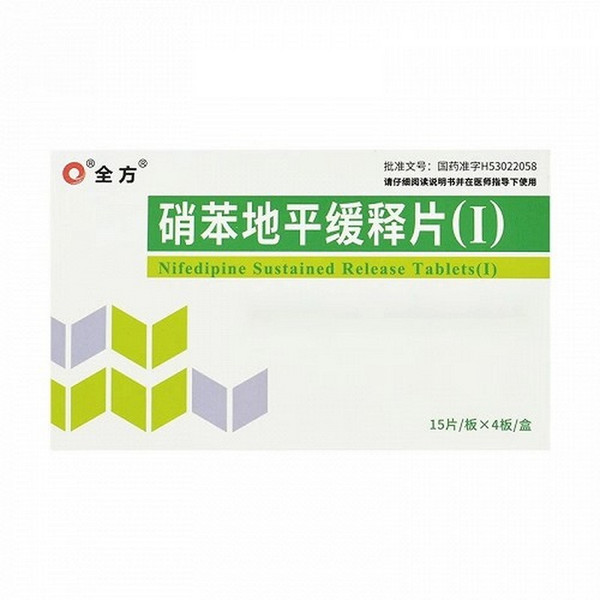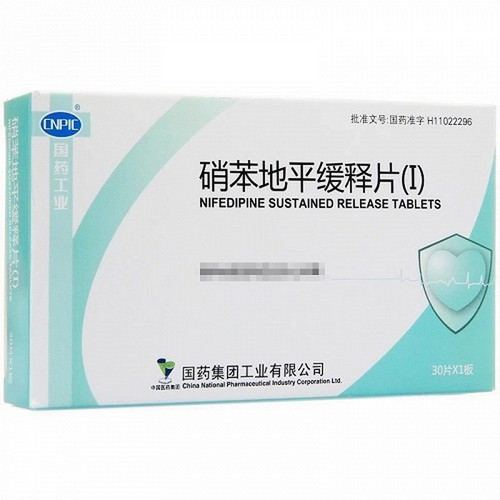Product Overview
[Drug Name]
Generic Name: Nifedipine Sustained-Release Tablets (I)
Trade Name: Quanfang Nifedipine Sustained-Release Tablets (I) 10mg*15 Tablets*4 Plates (Film-Coated Tablets)
Pinyin Full Code: QuanFang XiaoBenDiPingHuanShiPian(I)10mg*15Tablets*4Ban (BaoMoYiPian)
[Main Ingredients]
Nifedipine. 2,6-Dimethyl-4-(2-nitrophenyl)-1,4-dihydro-3,5-pyridinedicarboxylate. Molecular Formula: C₁ₐH₁₈N₂O₆. Molecular Weight: 346.34
[Properties]
This product is a film-coated tablet that appears yellow after removal of the film coating.
[Indications/Main Functions]
For the treatment of hypertension and angina pectoris. This includes angina pectoris caused by coronary artery spasm, variant angina pectoris, and typical angina pectoris or exertional angina pectoris caused by coronary artery obstruction.
[Specification]
10mg*15 tablets*4 plates (film-coated tablets)
[Usage and Dosage]
Oral: 10-20mg (1-2 tablets) at a time, twice a day. Maximum dose: 40mg (4 tablets) at a time, 0.12g (12 tablets) a day.
[Adverse Reactions]
1. Liver: Occasionally jaundice and elevated glutamate oxaloacetate aminotransferase and glutamate (propionate) aminotransferase may occur. 2. Circulatory system: Occasionally chest pain, headache, flushing, dizziness, palpitations, decreased blood pressure, lower limb edema, etc. may occur. 3. Allergies: Occasionally allergic symptoms such as measles and itching may occur. 4. Digestive system: Occasionally abdominal pain, nausea, loss of appetite, constipation, etc. may occur. 5. Oral cavity: Gingival hypertrophy may occur. 6. Metabolic abnormalities: Occasionally hyperglycemia may occur.
[Contraindications]
(1) Severe hypotension. (2) Severe aortic stenosis. (3) Allergic to this product.
[Precautions]
1. When discontinuing calcium antagonists, the dosage should be gradually reduced. Do not discontinue the medication without a doctor's instruction. 2. Use with caution in patients with hypotension. 3. Rodent experiments have shown teratogenic effects, but human studies are insufficient. The pros and cons must be weighed when using this product in pregnant women. 4. Clinical studies on breast milk are insufficient. It is best not to breastfeed if taking this product. 5. The half-life of this product may be prolonged in the elderly. Caution must be exercised when using this product. 6. Patients with aortic stenosis, liver or kidney function Use with caution in patients with potential damage. 7. Blood pressure and electrocardiogram must be monitored during medication, especially when deciding the dosage when starting medication and when increasing the dosage from a maintenance dose. 8. Interference with diagnosis: When using this product, alkaline phosphatase, creatine kinase, lactate dehydrogenase, ALT, and AST may occasionally increase, but without symptoms. Platelet aggregation rate may be reduced and bleeding time may be prolonged. 9. Hypotension may occur in case of overdose. In this case, the drug should be discontinued for observation and, if necessary, vasoconstrictors may be used. 10. U.S. FDA pregnancy drug safety classification: C for oral administration.







